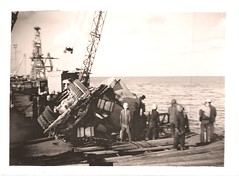Author: Nancy White
Agile Retrospectives
Earlier today I blogged about learning from mistakes/failures, particularly with After Action Reviews. John Smith points out another method, Agile Retrospectives (although he is talking about this in the context of communities of pratice). Learning Alliances » Communities of practice by any other name.
Take a peek at the video… Agile Retrospectives
Learning from our mistakes
 Michael Krigsman has a good story today on ZDNet about transparency and learning. He analyzes Amazon S3 team’s After Action Review (AAR) process following a disruption in their service. This reminds me of the importance of learning from failures and mistakes, rather than forgetting or covering them up. In fact there is a whole community dedicated to learning from mistakes, The Mistake Bank. Here is a quick recap of the useful practices Amazon deployed when they had a breakdown in their services. I’ve edited out some of the text so as not to cross ZDNet’s copyright, so click into the story for the full details.
Michael Krigsman has a good story today on ZDNet about transparency and learning. He analyzes Amazon S3 team’s After Action Review (AAR) process following a disruption in their service. This reminds me of the importance of learning from failures and mistakes, rather than forgetting or covering them up. In fact there is a whole community dedicated to learning from mistakes, The Mistake Bank. Here is a quick recap of the useful practices Amazon deployed when they had a breakdown in their services. I’ve edited out some of the text so as not to cross ZDNet’s copyright, so click into the story for the full details.
Amazon’s S3 post-mortem demonstrates maturity | IT Project Failures | ZDNet.com
THE PROJECT FAILURES ANALYSIS
In analyzing the failure, Amazon asked four questions:
What happened? The first step to a successful post-mortem is establishing a clear understanding of what went wrong. You can’t analyze what you don’t understand.
Why did it happen? After after determining the facts, the post-mortem team should assess why failure occurred….
How did we respond and recover? … A useful post-mortem depends on the analysis team gaining a reasonable level of honesty, insight, and cooperation from the organization.
How can we prevent similar unexpected issues from having system-wide impact? … Planning must also consider the business process and management responses the team initiates when a failure occurs. A complete post-mortem addresses both technical and management issues.
Amazon’s technical failure disrupted its customers’ business and hurt the company’s credibility. However, their open and transparent response to the failure and its aftermath demonstrates a level of organizational maturity rarely found among Enterprise 2.0 companies.
Pulling our mistakes out and looking with them, alone and with the aid of colleagues, is a simple and effective learning practice. But it takes both a personal commitment to productively looking at our warts (rather than simple self-flagellation or guilt) and an organizational culture that values learning along with success. And we all know it… we learn more from our failures than our successes. 😉
Here are a few resources for learning from mistakes and failures (some repeated from embedded links above, but I want to make it easy to scan for the resources!):
- After Action Review
- The Mistake Bank
- In Praise of Brilliant Failure (I like the brilliant part!)
- Scott Berkun on experiments as a place for productive failure
- The Ten Commandments of Business Failure – new book by Donald R. Keough
(haven’t read it – looks interesting)
Have any to add? Knowledge sharing in action!
Photo Credit: Flickr/CC
Slow Community from the individual perspective
 Will Richardson and Sheryl Nussbaum have taken the slow community idea and pulled it back to the individual participation perspective. I had been thinking about how a community makes choices, as a whole, about it’s speed or flow, but this reminds me that the cumulative impact of individual member choices also impacts the community speed (or slowness.) And that ignoring the choices also has an effect.
Will Richardson and Sheryl Nussbaum have taken the slow community idea and pulled it back to the individual participation perspective. I had been thinking about how a community makes choices, as a whole, about it’s speed or flow, but this reminds me that the cumulative impact of individual member choices also impacts the community speed (or slowness.) And that ignoring the choices also has an effect.
It is nice to get the different perspectives. (Plus it has been really cool to see other people thinking and blogging about slow community.)
Went for a couple of days to Virginia Beach to visit with Sheryl and her family and we spent a lot of time in a boat on the bay fishing and reading and chatting. In talking with her son Noah about how connected we all seem to be (text messages in between casts, etc.) one of us hit on the phrase above, and it bounced around in my brain for a bit. It seemed to fit the place I’m in right now, attempting, with pretty good success, actually, to control my connectedness, and to let the conversations happen elsewhere, jumping in when I feel compelled. Connecting, (ironically) to Nancy White’s idea of slow communities (like slow food) and wondering some more about the process of network participation and how much pull is too much pull, etc.
Photo Credit:
Community curriculum
 Dave Cormier pinged me the other day while I was away from my computer and pointed me to the reflections of a participant in the two week workshop he has just been facilitating on “Educational Technology and the Adult Learner.” (He also called it a “community curriculum.”) The post warmed the cockles of my heart. Thanks, Dave.
Dave Cormier pinged me the other day while I was away from my computer and pointed me to the reflections of a participant in the two week workshop he has just been facilitating on “Educational Technology and the Adult Learner.” (He also called it a “community curriculum.”) The post warmed the cockles of my heart. Thanks, Dave.
Leslie’s Last Day reflections | ED366H Educational Technology and the Adult Learner
I leave the class with new connections and community networks, there is that community word that keeps popping up. Along with the curriculum I left with alot of great advice and direction from fellow learners. I have a much better sense of virtual communities for social and professional networking. We so often hear that people don’t communicate any more, well looks like we communicate with many more and it is creating alot of great work. It is like the collective consciousness we hear about, technology is helping us to tap into it and to help manifest it exponentially.
Dave reflected that the two week experiment tossed people in deep and created an experience. He wrote about his overarching goal:
There were three main goals that I was hoping for from the course… all hoping to change the focus from ‘the material’ to the ‘experience’.
Sometimes I call these “transformative experiences” – often accompanied by some degree of discomfort and angst until the view gets sorted out a bit. But it also creates the community of learning, forged out of the challenge. Again, Dave wrote:
Community Literacies esp. Community commitment
Maybe the most important part of the of a course like this are the community literacies that are accumulated through a community enquiry into new material. The learners found that they could work together and rely on each other. They wrote nightly reflections and commented and helped each other with their work and reactions to the course. the sense of ‘competition’ between students evaporated. A sense of responsibility to the work at hand became stronger as the students found less and less direct guidance coming from the front of the room.They also got a sense of how I relate with my own online community and how that serves me in my own professional and, indeed, personal ways. Knowing that we have a community to rely on can be as much an emotional support to our practice as a technical one. Each student has remarked, in one sense or another, how their nightly blogging (closed, sadly) has allowed them to understand that they weren’t alone in their moments of frustration or overwhelmedness. Thinking of your professional life as something that can contain a community that can do all those things can be a very powerful realization.
Notice the reflective practice here, that pulls the learning out of the leap.
I find working with online interaction and the variety of tools and media at our disposal starts making more sense only after a deep dive. That tickling on the surface doesn’t reveal the possibilities as well as jumping in all the way, even if it makes us feel inadequate or lost.
This makes it harder to convince the reluctant. It reminds me of the Guillaume Apollinaire quote:
Come to the edge, he said.
They said: We are afraid.
Come to the edge, he said.
They came.
He pushed them…. and they flew.
Photo Credit:
![]() Uploaded on November 3, 2007
Uploaded on November 3, 2007
by laurenatclemson